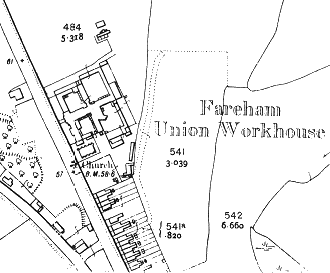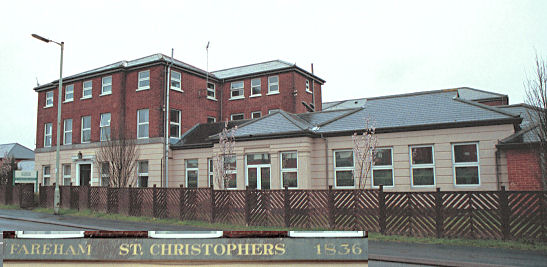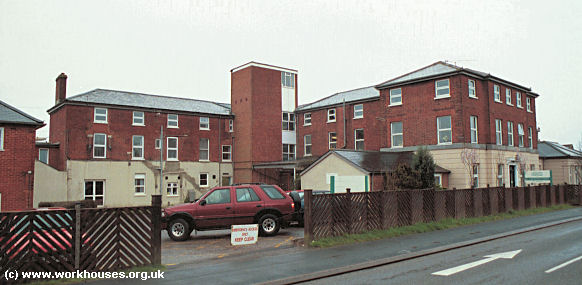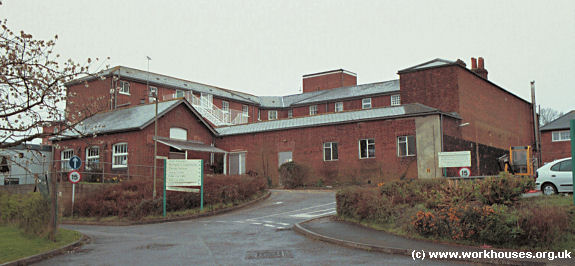Fareham, Hampshire
Up to 1834
A parliamentary report of 1777 recorded parish workhouses in operation in Fareham (for up to 60 inmates), Southwick (18), and Titchfield (80).
In 1785, Wymering (or Wymmering) leased a house at Cosham for use as a poorhouse. A workhouse also operated at Wickham.
After 1834
Fareham Poor Law Union was formed on 26th May 1835. Its operation was overseen by an elected Board of Guardians, 15 in number, representing its 9 constituent parishes as listed below (figures in brackets indicate numbers of Guardians if more than one):
Hampshire: Boarhunt, Fareham (4), Porchester, Rowner, Southwick, Titchfield (3), Wickham (2), Widley, Wymmering.
The population falling within the union at the 1831 census had been 12,137 — ranging from Rowner (population 140) to Fareham itself (4,402). The average annual poor-rate expenditure for the period 1831-34 had been £10,708 or 17s.8d. per head of the population.
A new Fareham Union workhouse was erected in 1836 on the London Road, now Wickham Road. Intended to accommodate 300 inmates, the Poor Law Commissioners authorized the sum of £5,500 on its construction. It was designed by Thomas Ellis Owen and was based on the popular cruciform or "square" plan with an entrance block at the front, behind which lay the four accommodation wings radiating from a central hub, creating yards for the different classes of pauper (male/female, old/young). The workhouse location and layout are shown on the 1908 map below.

Fareham workhouse site, 1908.
A chapel was erected at the south of the workhouse in 1849.

Fareham entrance block from the south-west, 2001.

Fareham from the north-west, 2001.

Fareham from the north, 2001.
In 1837, the new workhouse became embroiled in a scandal concerning its treatment of three young boys from the neighbouring Droxford union, who were temporarily being housed at Fareham. The three boys, aged from four to six years old, were William Warren, Robert Withers and Jonathan Cooke. Warren had left the Droxford workhouse at Bishop's Waltham in good health on 8th October, 1836, followed by the Withers and Cooke some time later. When they returned to Bishop's Waltham on 10th February, 1837, they were found to be weak and sick, infected with "the itch" (scabies), had marks on their bodies, and had apparently made the seven-mile journey on an open cart without any outdoor clothes. Following a reference to the case in a parliamentary speech by MP John Walter II, proprietor of The Times and a opponent of the New Poor Law, the Poor Law Commissioners launched an inquiry into events at Fareham. The Master of the Fareham workhouse, Thomas Bourne, said that all three children regularly wet or fouled their beds. His usually method for dealing with "dirty children" was to punish them by reducing their food. He also birched small children without recourse to approval from the Board of Guardians. Bourne claimed that, after observing a decline in the health of the boys, he had asked the medical officer to examine them, but that no medicine had been prescribed. The medical officer, John Blatherwick, said he did not recall such examinations having been made and said that the health of the Droxford children was similar to others in the workhouse. The schoolmistress at Fareham, Harriet Crouch, admitted that she might have whipped the children with a birch twig. It was also her custom to punish children by making them wear a dunce's cap bearing the word "Dirty" or by placing them for a period in a set of stocks that she had brought from her previous employment at a private school. At the end of their time at Fareham, the boys were housed for ten days in an outhouse which had a cold stone floor and no fireplace. The boys were only allowed out when their clothes were clean and dry, but were frequently confined to bed while their clothes were being washed. Withers was subsequently diagnosed as having a medical condition knwn as prolapsus ani. At the end of the inquiry, Thomas Bourne and John Blatherwick were both criticised for neglect. Neither was dismissed from his post, however, although Blatherwick subsequently resigned his position.
After 1930, the workhouse became a Public Assistance Institution under the control of Hampshire County Council. After 1948, it joined the National Health Service as St Christopher's Hospital, providing care for the chronic sick.The hospital closed in 2008 and almost all the buildings were demolished the following year. Only the entrance block survives, now converted to residential use.
Staff
Inmates
Records
Note: many repositories impose a closure period of up to 100 years for records identifying individuals. Before travelling a long distance, always check that the records you want to consult will be available.
- Hampshire Record Office, Sussex Street, Winchester SO23 8TH. Holdings include: Guardians' minute books (1835-1930); Births (1914-30); Deaths (1914-43); Casuals admissions and discharges (1924-25); Garden and pig journals (1891-1949); etc.
Bibliography
- Higginbotham, Peter The Workhouse Encyclopedia (2014, The History Press)
Links
- None.
Unless otherwise indicated, this page () is copyright Peter Higginbotham. Contents may not be reproduced without permission.


